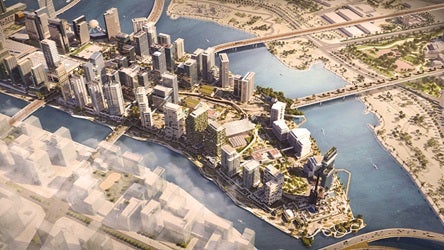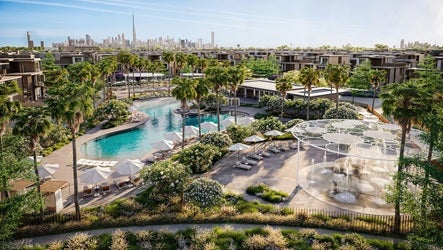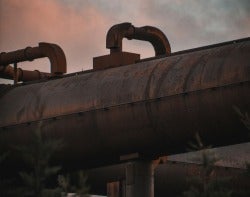Region advances LNG projects with pace
30 August 2024

Global liquefied natural gas (LNG) liquefaction capacity is expected to more than double by 2028, potentially increasing from 473 million tonnes a year (t/y) in 2023 to 968 million t/y in 2028 through new build and expansion projects, according to a recent report by GlobalData.
North America dominates globally among the regions, in terms of new build and expansion liquefaction capacity growth, contributing around 54% of the total global capacity additions or 268 million t/y by 2028, GlobalData says in the report.
The Middle East comes in at second position, followed by the Former Soviet Union, with capacity additions of 78 million t/y and 71 million t/y, respectively.
Since the start of this decade, there has been a sharp increase in investments in the Middle East and North Africa (Mena), and particularly in the Gulf region, in projects to expand LNG production. Capital expenditure close to $45bn has been made by Mena hydrocarbon producers in the past 10 years on various LNG projects, mainly for output capacity building, MEED Projects data shows. Almost three-fourths of that spending took place in the past four years, and predominantly in the GCC.
A desire to cater to the steady growth expected in global LNG demand and dominate the global supply market is fuelling the wave of investments into large-scale production capacity expansions and terminal construction by Gulf players.
Qatar guns for top spot
Qatar has been jostling with the US and Australia for the status of being the largest LNG provider to the world for many years now. The three countries have all clinched the top spot, only to be unseated by another the very next month.
However, when its mammoth North Field LNG expansion programme begins to come online later this decade, Qatar will be able to consolidate its position as the world’s largest producer and exporter of LNG in the long term.
State enterprise QatarEnergy is understood to have spent almost $30bn on the two phases of the North Field LNG expansion programme, North Field East and North Field South, which will increase its LNG production capacity from 77.5 million tonnes a year (t/y) to 126 million t/y by 2028. Engineering, procurement and construction (EPC) works on the two projects are making steady progress.
QatarEnergy awarded the main EPC contracts in 2021 for the North Field East project, which is projected to increase LNG output to 110 million t/y by 2025. The main $13bn EPC package, which covers the engineering, procurement, construction and installation of four LNG trains with capacities of 8 million t/y, was awarded to a consortium of Japan’s Chiyoda Corporation and France’s Technip Energies in February 2021.
QatarEnergy awarded the $10bn main EPC contract for the North Field South LNG project, covering two large LNG processing trains, to a consortium of Technip Energies and Lebanon-based Consolidated Contractors Company (CCC) in May last year.
When fully commissioned, the first two phases of the North Field LNG expansion programme will contribute a total supply capacity of 48 million t/y to the global LNG market.
Qatar is, however, not stopping at that. QatarEnergy, in February, announced a third phase of its North Field LNG expansion programme. To be called North Field West, the project will further increase QatarEnergy’s LNG production capacity to 142 million t/y when it is commissioned by 2030.
The North Field West project will have an LNG production capacity of 16 million t/y, which is expected to be achieved through two 8 million t/y LNG processing trains, based on the two earlier phases of QatarEnergy’s LNG expansion programme. The new project derives its name from the western zone of Qatar’s North Field offshore gas reserve, from where it will draw feedstock for LNG production.
Oman moves up the ladder
Oman has been supplying LNG to customers, mainly in Asia, for many years now. Majority state-owned Oman LNG operates three gas liquefaction trains at its site in Qalhat, with a nameplate capacity of 10.4 million t/y. Due to debottlenecking, the company’s complex now has a production capacity of about 11.4 million t/y.
As recently as late July, the Omani government announced that Oman LNG will build a new train at its Qalhat LNG production complex in Sur, located in the sultanate’s South Al-Sharqiyah governorate. Oman LNG will perform the preliminary engineering study for the planned LNG train.
The LNG train will have an output capacity of 3.8 million t/y. When commissioned in 2029, it will increase Oman LNG’s total production capacity to 15.2 million t/y.
Aside from Oman LNG, France’s TotalEnergies has now committed itself to becoming a major LNG supplier in the sultanate. In partnership with state energy holding conglomerate OQ, TotalEnergies achieved final investment decision earlier this year for a major LNG bunkering and export terminal in Oman’s northern city of Sohar.
TotalEnergies leads a joint venture named Marsa LNG, which is the Sohar LNG terminal project developer. Marsa LNG was formed in December 2021 through an agreement between TotalEnergies and the sultanate’s state energy holding company OQ. The partners own 80% and 20% stakes, respectively.
Marsa LNG intends to develop an integrated facility consisting of upstream units that will draw natural gas feedstock from TotalEnergies’ hydrocarbon concessions in the sultanate, particularly from Blocks 10 and 11; an LNG bunkering terminal and storage units located in Sohar port; and a solar photovoltaic plant to power the LNG terminal.
The Marsa LNG terminal will have a single train with the capacity to process about 1 million t/y of natural gas into LNG. The bunkering terminal will mainly supply LNG as a marine fuel to vessels. Marsa LNG has picked France-based Technip Energies to perform EPC works on the estimated $1bn LNG terminal project.
Adnoc gives shape to ambitions
Abu Dhabi National Oil Company (Adnoc) has been a relatively smaller LNG producer in comparison to its GCC peers. Adnoc Group subsidiary, Adnoc Gas, operates three large gas processing trains on Das Island. At its Das Island terminal, Adnoc Gas has an LNG liquefaction and export capacity of about 6 million t/y. The first and second trains were commissioned in the 1970s and have a combined output capacity of 2.9 million t/y. The third train came into operation in the mid-1990s, with a capacity of 3.2 million t/y.
Adnoc Gas’ LNG production and export capability, however, will receive a major fillip when a new greenfield terminal it has committed to developing in Ruwais, Abu Dhabi, comes online before the end of this decade. The planned LNG export terminal in Ruwais will have the capacity to produce about 9.6 million t/y of LNG from two processing trains, each with a capacity of 4.8 million t/y.
Adnoc awarded the full EPC contract and achieved the final investment decision for the LNG terminal complex in June. A consortium of France’s Technip Energies, Japan-based JGC Corporation and Abu Dhabi-owned NMDC Energy was awarded the EPC contract, worth $5.5bn.
Jordan takes a step forward
Jordan imports more than 90% of its oil, gas and refined product needs and therefore has a strong economic case for developing projects to boost its domestic hydrocarbon infrastructure, particularly for gas.
The country recently took a key step forward when Aqaba Development Corporation awarded the main EPC contract in August for a project to develop the Sheikh Sabah Al-Ahmad Al-Jaber Al-Sabah LNG onshore regasification facility at the port of Aqaba.
The contract was won by a consortium of Singapore-based AG&P and South Korea’s Gas Entec, along with their local partner, Jordan’s Issa Haddadin.
In a statement, Gas Entec said that the facility will have the capacity to process 720 million cubic feet a day of natural gas.
“Jordan relies heavily on natural gas for its power and industrial needs, but faces challenges with supply reliability,” Gas Entec said.
“The new LNG terminal will provide Jordan with the flexibility to access LNG from various global suppliers, ensuring a stable and secure energy source.”
Exclusive from Meed
-
 Regional rail industry emerges
Regional rail industry emerges8 December 2025
-
 Aldar and Mubadala plan $16bn financial district expansion
Aldar and Mubadala plan $16bn financial district expansion8 December 2025
-
 Visa agrees to support digital payments in Syria
Visa agrees to support digital payments in Syria5 December 2025
-
 Meraas announces next phase of Nad Al-Sheba Gardens
Meraas announces next phase of Nad Al-Sheba Gardens5 December 2025
-
 Frontrunner emerges for Riyadh-Qassim IWTP
Frontrunner emerges for Riyadh-Qassim IWTP5 December 2025
All of this is only 1% of what MEED.com has to offer
Subscribe now and unlock all the 153,671 articles on MEED.com
- All the latest news, data, and market intelligence across MENA at your fingerprints
- First-hand updates and inside information on projects, clients and competitors that matter to you
- 20 years' archive of information, data, and news for you to access at your convenience
- Strategize to succeed and minimise risks with timely analysis of current and future market trends

Related Articles
-
 Regional rail industry emerges
Regional rail industry emerges8 December 2025
 Commentary
Commentary
Colin Foreman
EditorRead the December issue of MEED Business Review
The GCC is experiencing a fundamental shift in its approach to rail infrastructure, as it moves from standalone projects to a self-sustaining regional industry. The transition is evident as local, national and regional projects advance across the region.
The first wave of metro systems, in Dubai, Doha, and most recently, Riyadh, have reported stronger-than-expected ridership and demonstrated the viability of mass transit in the Gulf.
Extensions to those networks are planned or under way, including Dubai’s Blue and Gold lines and Riyadh’s Line 2, alongside planned metros elsewhere such as Muscat and Bahrain.
Projects are also planned and already being delivered at the national level. The UAE’s Etihad Rail and Saudi Arabian Railways are leading most of these efforts. The region’s first cross-border project is also progressing with the Hafeet Rail scheme linking the UAE and Oman.
Other cross-border schemes are planned, including high speed links connecting Riyadh with Doha and Kuwait City, and rail links for Bahrain across causeways to Saudi Arabia and Qatar. The ultimate ambition is a GCC Rail network – a project that was reinvigorated by the Al-Ula accords in 2021.
Sustained, simultaneous activity across the GCC is fostering the development of an indigenous regional rail industry. Rather than being executed as isolated endeavours, projects are creating ongoing demand for expertise, personnel and resources within the region.
Project delivery capability will be complemented by the establishment of crucial ancillary services, including fabrication and servicing facilities.
These operations will shift the GCC from a lucrative market for international contractors to a regional hub for the rail industry, capable of servicing and sustaining its growing network.
 READ THE DECEMBER 2025 MEED BUSINESS REVIEW – click here to view PDF
READ THE DECEMBER 2025 MEED BUSINESS REVIEW – click here to view PDFProspects widen as Middle East rail projects are delivered; India’s L&T storms up MEED’s EPC contractor ranking; Manama balances growth with fiscal challenges
Distributed to senior decision-makers in the region and around the world, the December 2025 edition of MEED Business Review includes:
> AGENDA 1: Regional rail construction surges ahead> INDUSTRY REPORT 1: Larsen & Toubro climbs EPC contractor ranking> INDUSTRY REPORT 2: Chinese firms expand oil and gas presence> CONSTRUCTION: Aramco Stadium races towards completion> RENEWABLES: UAE moves ahead with $6bn solar and storage project> INTERVIEW: Engie pivots towards renewables projects> BAHRAIN MARKET FOCUS: Manama pursues reform amid strainTo see previous issues of MEED Business Review, please click herehttps://image.digitalinsightresearch.in/uploads/NewsArticle/15213797/main.gif -
 Aldar and Mubadala plan $16bn financial district expansion
Aldar and Mubadala plan $16bn financial district expansion8 December 2025
Register for MEED’s 14-day trial access
Abu Dhabi's sovereign wealth fund, Mubadala Investment Company, and local developer Aldar have established a joint venture to deliver an expansion of the financial district on Al-Maryah Island with a gross development value of AED60bn-plus ($16bn-plus).
The development will be built on the undeveloped land bank on the north side of Al-Maryah Island, covering about 500,000 square metres (sq m), and will support the next phase of growth for Abu Dhabi Global Market (ADGM).
The masterplan encompasses 1.5 million sq m of new office, residential, retail and hospitality floor space.
In an official statement, the firms said that the core objective of the project is to support the continued expansion of ADGM, Abu Dhabi’s international financial centre. ADGM now has more than 11,000 active licences registered in the free zone and is among the fastest-growing financial hubs globally.
"Nearly 40,000 people are already based within the district, and demand for space remains strong," the statement added.
The Al-Maryah Island expansion will add over 450,000 sq m of Grade A office space, doubling the island’s current office inventory.
The expansion will add over 3,000 residences on the waterfront.
The next phase will also add a further 40,000 sq m of retail and dining spaces.
A central feature of the expansion is the Al-Maryah Waterfront enhancement project. This will include a bay fountain capable of water displays up to 75 metres high, forming the focal point of a reconfigured waterfront with additional dining, leisure and event spaces designed to complement existing assets on the island.
Three new bridges are proposed to link the north side of Al-Maryah Island with Reem Island and the Abu Dhabi mainland, reducing travel time to Saadiyat Island to under 10 minutes.
The enabling works on these projects are due to begin in 2026.
The new joint venture is owned 60% by Aldar and 40% by Mubadala.
"The two organisations are close to completing the legal work on a retail joint venture that will own and operate several of Abu Dhabi’s leading retail destinations, including The Galleria Al-Maryah Island, Yas Mall and the planned Saadiyat Grove Mall," the statement added.
 READ THE DECEMBER 2025 MEED BUSINESS REVIEW – click here to view PDF
READ THE DECEMBER 2025 MEED BUSINESS REVIEW – click here to view PDFProspects widen as Middle East rail projects are delivered; India’s L&T storms up MEED’s EPC contractor ranking; Manama balances growth with fiscal challenges
Distributed to senior decision-makers in the region and around the world, the December 2025 edition of MEED Business Review includes:
> AGENDA 1: Regional rail construction surges ahead> INDUSTRY REPORT 1: Larsen & Toubro climbs EPC contractor ranking> INDUSTRY REPORT 2: Chinese firms expand oil and gas presence> CONSTRUCTION: Aramco Stadium races towards completion> RENEWABLES: UAE moves ahead with $6bn solar and storage project> INTERVIEW: Engie pivots towards renewables projects> BAHRAIN MARKET FOCUS: Manama pursues reform amid strainTo see previous issues of MEED Business Review, please click herehttps://image.digitalinsightresearch.in/uploads/NewsArticle/15213568/main.jpg -
 Visa agrees to support digital payments in Syria
Visa agrees to support digital payments in Syria5 December 2025
Visa and the Central Bank of Syria have agreed on a strategic roadmap that will allow the US-based card and digital payments company to begin operations in Syria and support the development of a modern digital payments system.
Under the agreement, Visa will work with licensed Syrian financial institutions under a phased plan to establish a secure foundation for digital payments.
The early stages will involve Visa supporting the central bank in issuing Europay, Mastercard and Visa (EMV)-compliant payment cards and enabling tokenised digital wallets – bringing the country in line with internationally interoperable standards.
Visa will also provide access to its platforms, including near-field communication (NFC) and QR-based payments, invest in local capacity building and support local entrepreneurs seeking to develop solutions leveraging Visa’s global platform.
“A reliable and transparent payment system is the bedrock of economic recovery and a catalyst that builds the confidence required for broader investment to flow into the country,” noted Visa’s senior VP for the Levant, Leila Serhan. “This partnership is about choosing a path where Syria can leapfrog decades of legacy infrastructure development and immediately adopt the secure, open platforms that power modern commerce.”
The move marks one of the most significant steps yet in Syria’s slow and uneven return to the formal global financial system and carries implications that reach beyond just payments technology.
It lays the groundwork for overturning more than a decade of financial isolation in which Syria has operated largely outside global banking and settlement networks.
Visa’s entry will not erase all existing barriers – as many restrictions remain in force and will continue to shape what is practically possible – but its support signals a reopening of channels that could smooth Syria’s reintegration into financial networks.
The involvement of the US-based payments provider is also a further tacit sign of the US government’s enthusiastic bear hug of the new post-Assad Syrian government under President Ahmed Al-Sharaa.
For investors assessing long-term opportunities, the presence of a globally recognised payments operator will provide reassurance that Syria’s financial system is returning to international norms, and the security and transparency that comes with it.
https://image.digitalinsightresearch.in/uploads/NewsArticle/15207198/main3225.gif -
 Meraas announces next phase of Nad Al-Sheba Gardens
Meraas announces next phase of Nad Al-Sheba Gardens5 December 2025
Dubai-based real estate developer Meraas Holding, which is part of Dubai Holding, has announced the eleventh and final phase of its Nad Al-Sheba Gardens residential community in Dubai.
It includes the development of 210 new villas and townhouses and a school, which will be located at the northwest corner of the development.
The latest announcement follows Meraas awarding a AED690m ($188m) contract for the construction of the fourth phase of the Nad Al-Sheba Gardens community in May, as MEED reported.
The contract was awarded to local firm Bhatia General Contracting.
The scope of the contract covers the construction of 92 townhouses, 96 villas and two pool houses.
The contract award came after Dubai-based investment company Shamal Holding awarded an estimated AED80m ($21m) contract to UK-based McLaren Construction last year for the Nad Al-Sheba Gardens mall.
The project covers the construction and interior fit-out of a two-storey mall, covering an area of approximately 12,600 square metres.
The UAE’s heightened real estate activity is in line with UK analytics firm GlobalData’s forecast that the construction industry in the country will register annual growth of 3.9% in 2025-27, supported by investments in infrastructure, renewable energy, oil and gas, housing, industrial and tourism projects.
The residential construction sector is expected to record an annual average growth rate of 2.7% in 2025-28, supported by private investments in the residential housing sector, along with government initiatives to meet rising housing demand.
https://image.digitalinsightresearch.in/uploads/NewsArticle/15206904/main.jpg -
 Frontrunner emerges for Riyadh-Qassim IWTP
Frontrunner emerges for Riyadh-Qassim IWTP5 December 2025

Saudi Arabia’s Vision Invest has emerged as frontrunner for the contract to develop the Riyadh-Qassim independent water transmission pipeline (IWTP) project, according to sources.
State water offtaker Saudi Water Partnership Company (SWPC) is preparing to award the contract for the IWTP "in the coming weeks", the sources told MEED.
The project, valued at about $2bn, will have a transmission capacity of 685,000 cubic metres a day. It will include a pipeline length of 859 kilometres (km) and a total storage capacity of 1.59 million cubic metres.
In September, MEED reported that bids had been submitted by two consortiums and one individual company.
The first consortium comprises Saudi firms Al-Jomaih Energy & Water, Al-Khorayef Water & Power Technologies, AlBawani Capital and Buhur for Investment Company.
The second consortium comprises Bahrain/Saudi Arabia-based Lamar Holding, the UAE's Etihad Water & Electricity (Ewec) and China’s Shaanxi Construction Installation Group.
The third bid was submitted by Saudi Arabia's Vision Invest.
It is understood that financial and technical bids have now been opened and Vision Invest is likely to be awarded the deal.
The Riyadh-based investment and development company made a "very aggressive" offer, one source told MEED.
In November, the firm announced it had sold a 10% stake in Saudi Arabia-based Miahona as part of a strategy to reallocate capital "towards new and diversified investments".
The company did not disclose which projects the capital might be reallocated towards.
As MEED recently reported, Vision Invest is also bidding for two major packages under Dubai's $22bn tunnels programme in a consortium with France's Suez Water Company.
The Riyadh-Qassim transmission project is the third IWTP contract to be tendered by SWPC since 2022.
The first two are the 150km Rayis-Rabigh IWTP, which is under construction, and the 603km Jubail-Buraydah IWTP, the contract for which was awarded to a team of Riyadh-based companies comprising Al-Jomaih Energy & Water, Nesma Group and Buhur for Investment Company.
Like the first two IWTPs, the Riyadh-Qassim IWTP project will be developed using a 35-year build-own-operate-transfer contracting model.
Commercial operations are expected to commence in the first quarter of 2030.
https://image.digitalinsightresearch.in/uploads/NewsArticle/15206609/main.jpg

 Global LNG demand set for steady growth
Global LNG demand set for steady growth